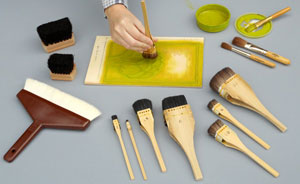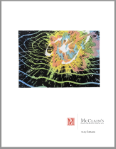
From left to right, Maru Bake #2 and #3, Professional Japanese Mizu Bake, Hanga Bake #1, Surikomi Bake #2, Hanga Bake #4 and #6, Surikomi Bake #10, #6 and #20 and Steiner Mixing Brushes, small round and large flat.
Uses for Stiff Brushes
The stiff bristled brushes shown in the top photograph are made for Moku Hanga (Japanese style printmaking). These brushes are used to mix ink and nori (paste) together and spread it out evenly on the wood block. They come in a wide range of sizes since the area to be covered on the wood block also varies widely.The ideal Moku Hanga brush is flexible, somewhat springy and not too soft. Maru Bake (which look like shoe brushes) and Hanga Bake (in the container on the right) are popular with professional printmakers in Japan. Surikomi Bake (the small brushes on the lower left and in the container on the left) are made to stencil fabric, but they also work very well for Moku Hanga, plus they are less expensive and come in a wide range of sizes.
Having a brush for each color used in a print is very convenient. Some people like to keep one set of brushes for dark colors and another set for light colors, since it is difficult to remove every bit of pigment from these very dense brushes.
Book artists use Surikomi Bake to spread paste. The brushes are not recommended for spreading PVA since it is very difficult to clean this nonreversible glue from the bristles completely.
Uses for Soft Brushes
The soft bristled brushes shown in the bottom photo are used in a number of different ways.Mizu Bake (the large brushes on the left and at the top of the page), with their short handles and thick, short bristles, are traditionally used to dampen and straighten paper. Today, sprayers are often used to dampen paper and the Mizu Bake's job is to brush that water out evenly over the paper.
Mizu Bake are also wonderful brushes for applying washes or dampening watercolor paper.
Magari Mizu Bake (upper left) are smaller versions of the larger brushes and are used to apply small amounts of water to paper or wood blocks. In China, they are used for watercolor painting.
The longer handled, longer bristled Dosa Bake (the larger brushes on the right) are traditionally used to apply dosa (sizing) to Washi (Japanese hand-made paper). Dosa is made from animal skin glue and alum mixed with water, and it is used to prevent water-based ink from being absorbed so quickly that it bleeds in the paper. Dosa Bake can also be used like a Mizu Bake to dampen paper.
In the center of the photo, on the right, are two small Steiner Mixing Brushes. These are great for mixing water-based ink or paint in a container and then transferring the ink onto the wood block. They are very absorbent and hold much more ink without dripping compared to inexpensive watercolor brushes. The short handle means they are less top-heavy so they are less likely to fall out of the container, especially Cuppers with their flat bottoms.
For more information about using and caring for brushes, please go to Learning Center and look under "Brushes."

